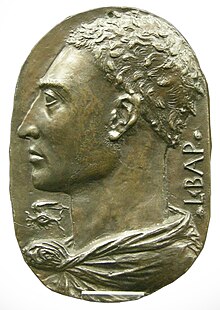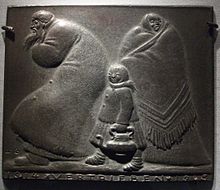Plaquette
They may be commemorative, but especially in the Renaissance and Mannerist periods were often made for purely decorative purposes, with often crowded scenes from religious, historical or mythological sources.
By about 1550 it had fallen from fashion in Italy, but French plaquettes were entering their best period, and there and in Germany they continued to be popular into the 17th century.
[3] To Renaissance Italians plaquettes were known, along with other similar types of objects, by a variety of somewhat vague terms such as piastra and medaglietti,[4] rilievi,[5] or modelli.
Around the same time north Italian artists began making plaquettes, often much larger and with religious subject matter.
[8] Two significant works, neither typical of later examples, were the self-portrait head by Leon Battista Alberti, oval and 20 cm high,[9] and a slightly larger circular Madonna and Child with putti by Donatello (Victoria and Albert Museum, London).
Other larger religious reliefs by Donatello were copied or adapted in a smaller plaquette format by other artists, probably including his own workshop.
[12] Significant later artists included Moderno (as he signed many of his works), who was very likely Galleazzo Mondella, a goldsmith from Verona recorded in Rome around 1500.
[13] Andrea Riccio,[14] Giovanni Bernardi,[15] Francesco di Giorgio Martini, Valerio Belli,[16] and Leone Leoni,[17] are among the artists to whom a clear name can be attached.
German examples tended to draw their designs from prints, and were in turn frequently reused in other media, and perhaps more often produced primarily as models for other trades.
[23] Especially in France and Germany, commemorative plaquettes for industry and institutions involved a wide range of contemporary subject matter.
The circular so-called "death penny" (the Memorial Plaque) minted in the UK after World War I is a large twentieth-century commemorative example.
[25] In early 16th-century Nuremberg, which was the main German centre,[26] plaquettes, like other metalwork types of objects, were often made in the relatively plebeian material of brass, even by top artists like the Vischer family and Peter Flötner.
The purpose and use of decorative plaquettes was evidently varied and remains somewhat unclear; their creation and use is relatively poorly documented.
They are best appreciated when held in the hand near a good light source, and were probably passed round when a collection was shown to fellow connoisseurs.
The difficulty of reading the scenes, and an often obscure choice of subjects, suggest that a self-conscious display of classical learning was part of their appeal, for collectors and artists alike.
They were one of the types of objects often found in the – normally male – environment of the studiolo and cabinet of curiosities, along with other small forms such as classical coins and engraved gems.
[35] The artists who made them tended to be either sculptors in bronze, also making small figures and objects such as inkwells, or goldsmiths, who often practised in the related field of engraving.
They were relatively cheap and transportable, and were soon disseminated widely across Europe, offering an opportunity for artists to display their virtuosity and sophistication, and promote themselves beyond their own city.
[37] Plaquettes, like prints, played an important part in the diffusion of styles and trends in iconography, especially for classical subjects.
The Bargello in Florence has some 400 plaquettes, about half from the collection of the Medici family, who played an important role in the development of the form.






